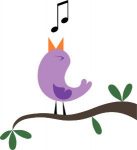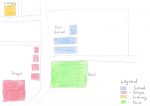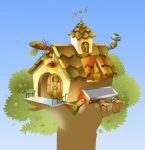 NAPLAN’s over and it’s time to sink our teeth into the main body of curriculum work before mid-year reporting rolls around. Our younger students are using all their senses to study the environment and local area around them, whilst our older students are hard at work on their Explorer projects.
NAPLAN’s over and it’s time to sink our teeth into the main body of curriculum work before mid-year reporting rolls around. Our younger students are using all their senses to study the environment and local area around them, whilst our older students are hard at work on their Explorer projects.
Foundation/Prep/Kindy to Year 3
Unit F.2 for stand-alone Foundation/Prep/Kindy classes has the students continuing to think about their Favourite Place. This week students are considering what they can hear in their Favourite Place and how they will depict that in their model of their Favourite Place. Students can also think about what their Favourite Sounds are and whether or not these would occur in their Favourite Place. Students in integrated Foundation/Prep/Kindy classes (Unit F.6) and Years 1 (Unit 1.2), 2 (Unit 2.2) and 3 (Unit 3.2) have this week set aside for an excursion to a local park or area of heritage significance. If an excursion outside school grounds is impractical teachers can achieve similar results from an excursion around the school and oval. Students are using their senses to interpret their environment, as well as thinking about living and non-living things, natural and managed landscapes and sources of heat and light.
Years 3 to 6
 Students in Years 3 (Unit 3.6), 4 (Unit 4.2), 5 (Unit 5.2) and 6 (Unit 6.2) are continuing their project on an explorer. This week the focus for most students is on animals which may have been encountered by their explorer. Year 3 students are examining animals from different climate zones and how they are adapted to deal with climate extremes. Students in Years 4 and 5 look at extinct animals from Africa, South America or North America, assessing impact and sustainability issues. Students in Year 4 (and optionally as an extension for Year 3) consider the life cycle of their chosen animal. Students in years 4, 5 and 6 also start to examine the differences between Primary and Secondary sources and some of the OpenSTEM resources contain quotes or copies of primary material, so that students can refer to these in their project. Year 6 students are examining the changing Economies and Politics of Asia through time, in order to place the explorations within a broader context and to gain a greater understanding of the development of the global situation. Students have another 2 weeks to complete their presentation on their explorer (including environment and other aspects), before assessment of this project.
Students in Years 3 (Unit 3.6), 4 (Unit 4.2), 5 (Unit 5.2) and 6 (Unit 6.2) are continuing their project on an explorer. This week the focus for most students is on animals which may have been encountered by their explorer. Year 3 students are examining animals from different climate zones and how they are adapted to deal with climate extremes. Students in Years 4 and 5 look at extinct animals from Africa, South America or North America, assessing impact and sustainability issues. Students in Year 4 (and optionally as an extension for Year 3) consider the life cycle of their chosen animal. Students in years 4, 5 and 6 also start to examine the differences between Primary and Secondary sources and some of the OpenSTEM resources contain quotes or copies of primary material, so that students can refer to these in their project. Year 6 students are examining the changing Economies and Politics of Asia through time, in order to place the explorations within a broader context and to gain a greater understanding of the development of the global situation. Students have another 2 weeks to complete their presentation on their explorer (including environment and other aspects), before assessment of this project.

 It’s NAPLAN week and that means time is short! Fortunately, the Understanding Our World™ program is based on 9 week units, which means that if you run out of time in any particular week, it’s not a disaster. Furthermore, we have made sure that there is plenty of catch-up time within the lessons, so that there is no need to feel rushed. This week students are getting into the nitty gritty of their term projects. Our youngest students are studying their surroundings at school and in the local area. Older students are getting to the core of their research projects.
It’s NAPLAN week and that means time is short! Fortunately, the Understanding Our World™ program is based on 9 week units, which means that if you run out of time in any particular week, it’s not a disaster. Furthermore, we have made sure that there is plenty of catch-up time within the lessons, so that there is no need to feel rushed. This week students are getting into the nitty gritty of their term projects. Our youngest students are studying their surroundings at school and in the local area. Older students are getting to the core of their research projects. Students in our standalone Foundation/Kindy/Prep class (
Students in our standalone Foundation/Kindy/Prep class ( Students in Year 3 (
Students in Year 3 ( This week all of our students start to get into the focus areas of their units. For our youngest students that means starting to examine their “
This week all of our students start to get into the focus areas of their units. For our youngest students that means starting to examine their “ Students doing our stand-alone Foundation/Kindy/Prep unit (
Students doing our stand-alone Foundation/Kindy/Prep unit ( Students in Years 3 to 6 start their research projects this week. Students doing unit
Students in Years 3 to 6 start their research projects this week. Students doing unit  Foundation to Year 3
Foundation to Year 3 Students in Years 3 to 6 (Units
Students in Years 3 to 6 (Units
The units have allowed students to engage in exciting content and learn new information and utilise thinking skills for various…
Trent Perry, Teacher